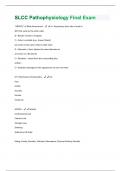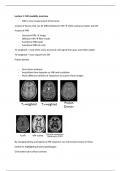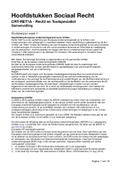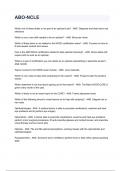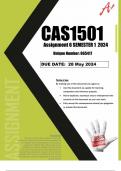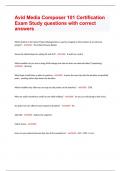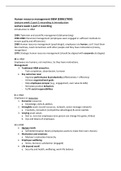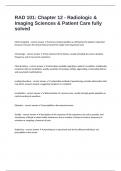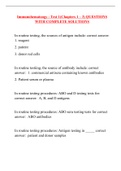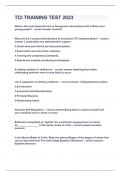related but otherwise unknown etiology. Frequency, urgency, straining to void, decreased urine stream, incontinence, impotence, palpable prostate, nocturia. Can give a false -positive PSA test Bleeding Times - anticoagulants PT Coumadin
SLCC Pathophysiology Final Exam Questions & Answers Rated 100% Correct
"ABCDE's" of Mole Assessment - A = Asymmetry (one side of mole is NOT the same as the other side) B = Border of mole is irregular. C = Color is variable (e.g., brown/ black/ tan colors in the same mole) or dark color. D = Diameter > 6mm (about the same diameter as an eraser on a #2 pencil) E = Elevation - raised from the surrounding skin, and/or... E = Evolution (changes) in the appearance of nevi over time 6 F's Risk Factors Cholecystitis - Fat Fare Fertile Fourties Female Family Hx ACCESS - Alcohol Corticosteroid use Calcium Low Estrogen Low Smoking Sedentary Life Style Eating, Family, Genetics, Lifestyle, Menopause, Physical Activity, SteroidsAcquired Immunity types - Naturally Acquired Passively-mother's milk Actively-infected with pathogen Artificially Acquired Passively-vaccine Actively-Serum gamma globulin Actinic Keratosis - Premalignant lesion from sun exposure that can → squamous cell carcinoma. Acute compartment syndrome - Occurs as a result of trauma or loss of blood supply to the appendage Acute Glomerulonephritis - *Immune Complex, RBC & Proteinuria, Periorbital Edema* caused by a group A strep Bacteria→Immune complex breaks filtration→autoimmune disorder Acute Renal Failure - *Potentially Reversible* Decrease Blood Flow←Trauma or ischemia Obstruction↔inflammatory response Glomerulonephritis Certain Medications Acute Respiratory Distress Syndrome - Starts with Acute lung injury/insult (ALI) First Stage→Respiratory Alkalosis→hyperventilation Intermediate stage→ACIDOSIS Respiratory→ hypoventilation and Metabolic K⁺ cell breakdown Intermediate stage→PULMONARY EDEMA →cell breakdown turns on inflammatory response Intermediate state→BLOOD CLOTTING platelets responds to inflammation further blocking perfusion Late stage→RESPIRATORY FAILURE continued acidosisAdrenal Gland Abnormalities - Addison's Disease→Hyposecretion of Adrenal Cortical Cushing's Disease→Hypersecretion of Adrenal Cortical Pheochromocytoma→Hypersecretion of catecholamines Airborne Precautions - "You're on the air with MTV" measels, tuberculosis, varicella Angioma - benign tumors derived from cells of the vascular or lymphatic vessel walls (endothelium) or derived from cells of the tissues surrounding these vessels Autonomic Dysreflexia - is an abnormal cardiovascular response to stimulation of the sympathetic division of the autonomic nervous system; occurs as a result of stimulation of the bladder, large intestine, or other visceral organs not being able to send correct signals Bacteria - Reproduces independently, does not need a host Gram positive-Exotoxin producing- toxin released when alive- less dangerous Gram negative-Endotoxin producing- toxin released when dead- more dangerous Bacteria Chlamydia and Rickettsia - Reproduce independently but need host cell for energy. Basal cell Carcinoma - Most Common- Least Lethal. Rarely metastasizes. A persistent, non-healing sore is a very common sign of an early BCC. Can be an open sore that bleeds, oozes, or crusts and remains open for a few weeks, only to heal up and then bleed again Benign prostatic hypertrophy (BPH) - Nonmalignant enlargement of the prostate gland. Agerelated but otherwise unknown etiology. Frequency, urgency, straining to void, decreased urine stream, incontinence, impotence, palpable prostate, nocturia. Can give a false-positive PSA test Bleeding Times - anticoagulants PT CoumadinPTT Heparin Blood Components - Myeloid Cells Bone RBC Kidney Erythropoietin WBC Thymus T-lymphocytes Platelets Liver Thrombopoietin Blood sugar - 70-130 mg/dL
Written for
- Institution
- SLCC Pathophysiology
- Course
- SLCC Pathophysiology
Document information
- Uploaded on
- July 5, 2024
- Number of pages
- 22
- Written in
- 2023/2024
- Type
- Exam (elaborations)
- Contains
- Questions & answers
Subjects
Content preview
related but otherwise unknown etiology. Frequency, urgency, straining to void, decreased urine stream, incontinence, impotence, palpable prostate, nocturia. Can give a false -positive PSA test Bleeding Times - anticoagulants PT Coumadin
Also available in package deal
